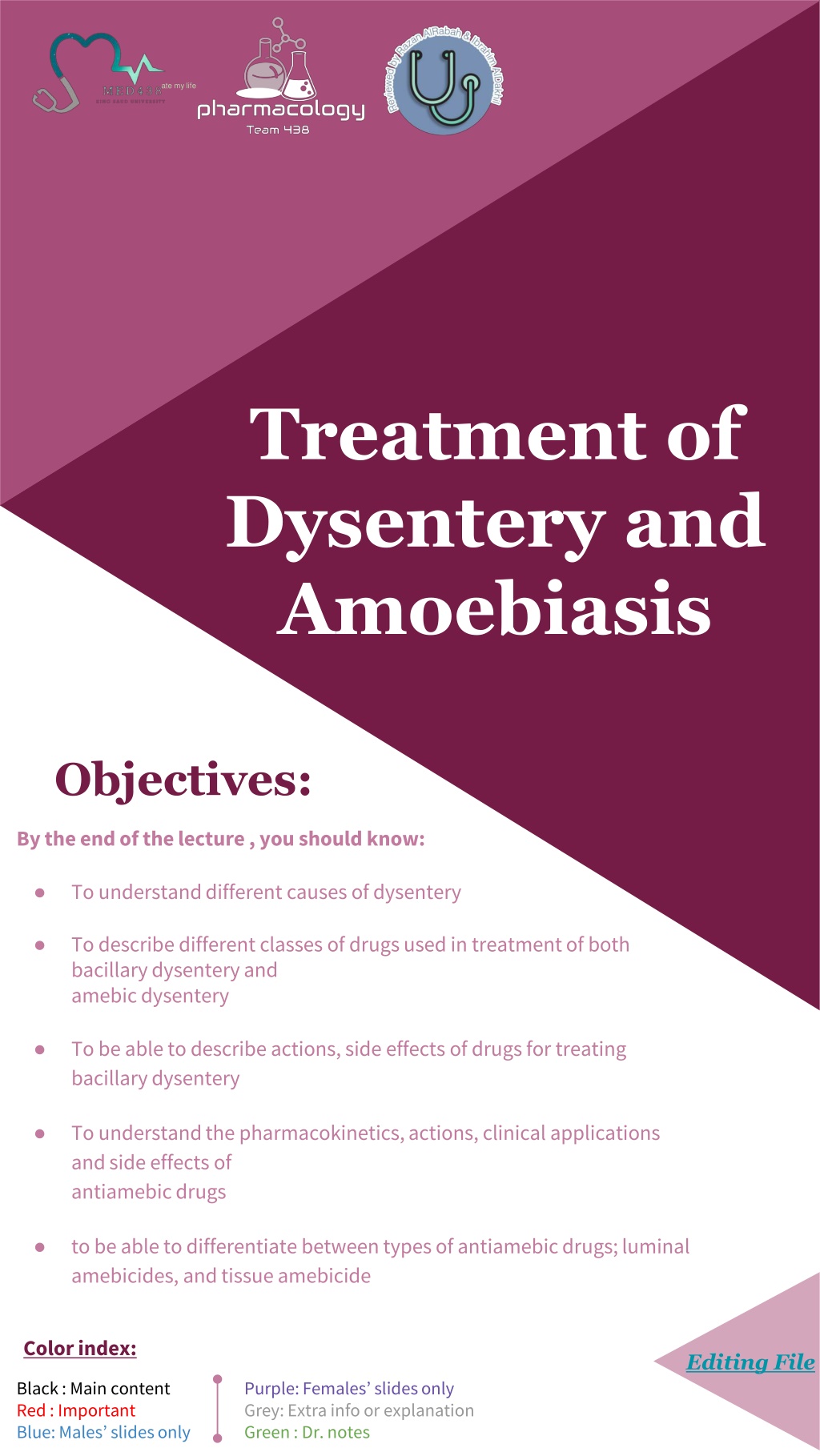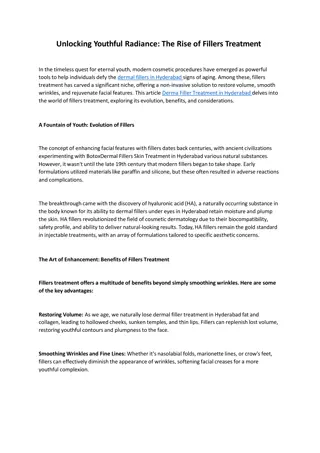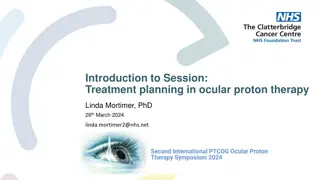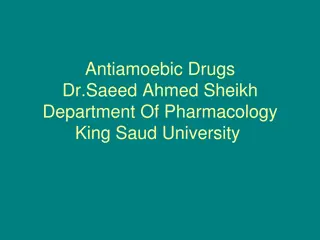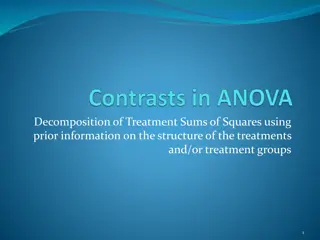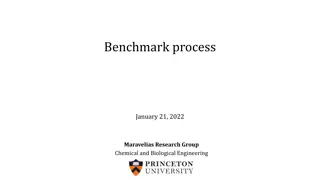Understanding the Treatment of Dysentery and Amoebiasis
Dysentery and amoebiasis are gastrointestinal diseases with different causes and treatments. Dysentery is an inflammatory disorder of the intestine, often caused by bacterial, viral, or parasitic infections. Antimicrobial agents and fluid intake management are key in treatment. Amoebiasis, caused by Entamoeba histolytica, presents with various stages in the life cycle and can lead to systemic invasion. Treatment involves reducing GI motility and considering antiparasitic drugs. Understanding the differences in causes and treatment approaches is essential in managing these conditions effectively.
Download Presentation

Please find below an Image/Link to download the presentation.
The content on the website is provided AS IS for your information and personal use only. It may not be sold, licensed, or shared on other websites without obtaining consent from the author. Download presentation by click this link. If you encounter any issues during the download, it is possible that the publisher has removed the file from their server.
E N D
Presentation Transcript
ate my life Treatment of Dysentery and Amoebiasis Objectives: By the end of the lecture , you should know: To understand different causes of dysentery To describe different classes of drugs used in treatment of both bacillary dysentery and amebic dysentery To be able to describe actions, side effects of drugs for treating bacillary dysentery To understand the pharmacokinetics, actions, clinical applications and side effects of antiamebic drugs to be able to differentiate between types of antiamebic drugs; luminal amebicides, and tissue amebicide Color index: Editing File Black : Main content Red : Important Blue: Males slides only Purple: Females slides only Grey: Extra info or explanation Green : Dr. notes
This is a story all about how my life got turned upside down Dysentery is an inflammatory disorder of the intestine, especially of the colon, that results in severe diarrhea containing mucus and/or blood in the feces with fever and abdominal pain caused by any kind of infection. Causes of Dysentery: The most common: Bacterial infection 02 Bacillary dysentery (bacterial infection mainly by shigella) Viral infection 01 03 01 Parasitic infection Amebic dysentery (Protozoal infection Mainly by Entamoeba Histolytica) Treatment: Antimicrobialagents should not be given until stool analysis is done to specify the etiological agent3 Maintain fluid intake using oral rehydrationtherapy or intravenous fluid therapy1. Antidiarrheal drugs2 Antidiarrheal Drugs Loperamide Common Diphenoxylate + Atropine4 Drug opioid-receptor agonist5 MOA -opioid receptors in the myenteric plexus of the large intestine. Do not cross BBB6 Minimal liability for addiction Can cross BBB Has high liability for addiction Side effects are mainly due to atropine. P.K Treatment should be avoided in: 1. presence of high fever 2. if the stool is bloody. 3. C. difficile infections They are contraindicated because they delay fecal excretion that can prolong fever, as it increases the risk of toxin retention7and precipitation of toxic megacolon. C.I Amebiasis Is a protozoal infection of the intestinal tract that occurs due to ingestion of foods or water contaminated with cysts of Entameba Histolytica 1: oral if patient is not vomiting, IV if patient cannot handle oral. 2:work by reducing GI motility, but has no antimicrobial effect. 3: so you could treat either with antiviral, antibacterial or antiparasitic. 4:Atropine is added to diphenoxylate to increase the side effects (purposally), to avoid patients getting addicted to it. 5: morphine derivatives, morphine itself is not used due to high liability for addiction.(synergist) 6: advantage over morphine and diphenoxylate. 7: the decrease in GI motility will not allow for the was out of the causative organism, preventing the body from getting rid of it.
Entamoeba histolytica exists in two form: -Multiply and feed on intestinal bacterial flora. -They may invade and ulcerate wall of large intestine or may migrate to liver or other tissues. -In rectum, trophozoites transform to cysts and are excreted in feces. -Can survive outside the human body. -When ingested, liberate trophozoites in the lumen of the intestine. Cysts (infective stage) Trophozoites (non-infective; invasive stage) Life cycle of Amebiasis: Invasion2 of intestinal wall and multiplication of trophozoites within colon wall Systemic invasion to other organs (liver, lungs, brain) Cysts ingestion in contaminated food or water Cyst formation in rectum and excretion in feces. Liberation of trophozoites in the colon1. Clinical Presentation: Asymptomatic (Lumenal) amebiasis = Carriers(passing cysts in stool) The patients show varying degree of illness from no symptoms to mild diarrhea to severe dysentery 1 2 3 4 Mild to moderate intestinal disease (colitis) Severe intestinal infection (amoebic dysentery) 5 6 Ameboma (localized granulomatous lesion of colon) Hepatic abscess, and other extra- intestinal disease Antiamebic drugs: Types Tissue or systemic amebicides3 Luminal amebicides4 Act on amoeba in tissues E.g. the intestinal wall and/or other extra-intestinal tissues as liver, brain, and lung. Site of Action Acts on the parasites in the lumen of the bowel Used for treatment of asymptomaticamebiasis (carriers). Used to eradicate cysts of E.histolytica after treatment of invasive disease. Used for treatment of systemic form of the disease (invasive amebiasis) e.g. intestinal wall infection or liver abscesses. Uses 1. 2. 3. Diloxanide furoate Iodoquinol Antibiotic: a. Paromomycin b. Tetracycline 1. 2. 3. Metronidazole/ tinidazole Emetine / dehydroemetine Chloroquine (liver only) Drugs 1: before invasion, the amoeba is only found in the colon, therefore at this stage (asymptomatic patients) Luminal amebicides are enough to treat. 2: once invasion occur, luminal amebicides are no longer enough alone, systemic amebicides should be used to eradicate the infection. 3: They are highly absorbable, allowing them to reach to systemic circulation and eradicate the organism from the systemic tissues. BUT they are not enough to eradicate the cysts from the intestines, thus, luminal amebicides SHOULD be administered after the systemic amebicides. 4: they are poorly absorbed, allowing them to act on the site of infection (the intestines).
A)Tissue or Systemic Amebicides Drug Metronidazole It is a Tissue amoebicide that acts on trophozoitesby: Inhibiting DNA replication Does not eradicate cysts from intestine due to good oral absorption. M.O.A Given orally or IV Absorption is rapid and complete Wide distribution to all tissues and body fluids (CSF, saliva, milk). Short Plasma half life is (8 h). Metabolized in liver (by CYP-450) by mixed function oxidase followed by glucuronidation (consider drug interactions). Clearance is decreased in liver impairment. Excreted in urine. P.K Drug of choicefor treating invasive amebic infections (intestinal & extraintestinal amebiasis) Should be followed by luminal amebicides Giardiasis Trichomoniasis Anaerobic bacterial infections Peptic ulcer (Helicobacter pylori)1. Pseudomembranous colitis (Clostridium difficile)2. Uses GIT: Dry mouth, metallic taste. Nausea, vomiting, diarrhea. Oral Thrush (Moniliasis, yeast infection). Other ADRs: Dysuria, dark urine, neutropenia. Disulfiram-like effect if taken with alcohol3. CNS: Neurotoxic effects Insomnia, dizziness Peripheral neuropathy, paresthesia. Encephalopathy, convulsion (IV infusion, rare). ADRs CNS diseases.(If I.V) Alcohol intake Pregnancy and breastfeeding women Severe renal disease Severe hepatic disease C.I Enzyme inhibitors E.g. cimetidine, ketoconazole increase duration of action of Metronidazole Drug Inter- action Enzyme inducers E.g phenytoin, phenobarbitone4 decreased duration of action of Metronidazole Metronidazole inhibitsCYP-450 (2C9 & 3A4) so: increases anticoagulant effect of warfarin Increases lithiumtoxicity Combining metronidazole and alcohol causes nausea, vomiting, abdominal distress, flushing, headache, tachycardia,hyperventilation. Alcohol inter- action Alcohol Aldehyde dehydrogenase Ethanol Acetaldehyde Acetate dehydrogenase 1: as part of the triple therapy (PPI + Clarithromycin + metronidazole 2: Vancomycin can also be used. 3: not only alcohol, other substances such as some antivirals could also cause disulfiram-like effect if given with metronidazole. 4: & rifampicin.
A)Tissue or Systemic Amebicides cont... Drug Tinidazole M.O.A Has similar activity to metronidazole but better potency Advantages of tinidazole : has longerduration of action (12-14h) a simplerdosing regimen1 a better toxicity profile than metronidazole2 P.K Drug Emetine Dehydroemetine Both are effective against tissue trophozoites of E. histolytica causing irreversible block of protein synthesis. M.O.A Emetine is an alkaloid derived from ipeca3while dehydroemetine is a synthetic analog. Have erratic oral absorption (not given orally). Given preferably subcutaneously but could be given IM, Never given as I.V4 Has long plasma half life about 5 days Should not be used for more than 10 days (usually 3-5 days) Metabolized & excreted slowlyvia kidney so they have a cumulative effect5. Because of major toxicity concernsthey have been almost completely replaced by metronidazole6. P.K Amoebic liver abscess Intestinal wall infections Severe forms of amebiasis acute amoebic dysentery, dehydroemetine is preferable due to less toxicity (3-5 days) Uses Dehydroemetine is less toxic than Emetine (safer) Serious toxicity:cardiotoxicity(Hypotension, cardiac arrhythmias, heart failure) GIT: nausea, vomiting, diarrhea ADRs Patients with cardiac or renal disease Young children Pregnancy C.I Drug Chloroquine M.O.A Anti-malarial drug. Used in combination7with metronidazole or dehydroemetinefor amebic liver diseases. Uses Pruritus is common Blurring of vision8 Hemolysis in G6PD deficient patients9 Nausea, vomiting, abdominal pain, anorexia ADRS 1: means less frequency of administration. 2: has the same side effects but to a lesser extent. 3: 4: Due to high CVS toxicity. 5: May cause the patient to reach to level of toxicity . 6: usually only used in countries where metronidazole & tinidazole are unavailable. 7: or alone 8: (ALERT: CNS flashbacks) due to retinal deposition (retinopathy). 9: oxidizing drugs should be avoided in patients with G6PD deficiencies (which include: Sulfa drugs, trimethoprim and chloroquine). .
B) Luminal Amebicides Drug Diloxanide furoate M.O.A is unknown Direct1amoebicidal action against luminal forms (Cyst) Not effective against trophozoites in intestinal wall or extra-intestinal tissues. M.O.A Ester of diloxanide +Furoic acid Given orally It splitin the intestine liberating diloxanide The little unabsorbed diloxanideis the amoebicidal agent The absorbed portionis excreted in urine P.K Drug of choicefor asymptomatic intestinal infection(cyst passers) To eradicate cysts of E.histolytica after treatment of invasive disease with systemic amebicides Uses Flatulence Nausea, vomiting, abdominal cramps. ADRs Pregnancy Children (less than 2 years). C.I Drug Iodoquinol M.O.A is unknown Effective against the luminal formsof amebiasis M.O.A Is given orally Poorly absorbed, excreted in feces. P.K Uses Luminal amoebicide for asymptomatic amebiasis GIT:Nausea,vomiting, diarrhea. Peripheral neuropathy including optic neuritis2 Enlargement of the thyroid gland2 Iodine sensitivity3 interference with thyroid function tests increase protein-bound serum iodine, decrease in measured (I131uptake). ADRs should be used with caution in patients with optic neuropathy, or thyroid disease discontinued if it produces persistent diarrhea or signs of iodine toxicity (dermatitis, urticaria, pruritus,fever) C.I 1: should come in contact with the infected tissue to be effective (which is the lumen of intestines). 2: Even though it is poorly absorbed, the small traces of iodine that is absorbed is enough to cause all of these ADRs. 3: drug should be DISCONTINUED if patient shows any sign of iodine toxicity such as urticaria or eczema.
B) Luminal Amebicides cont... Drug Paromomycin sulphate Aminoglycoside1antibiotic Direct amebicidal action: causes leakage by its action on cell membrane of parasite Indirect effect: killing of bacterial flora2essential for proliferation of pathogenic amoebae M.O.A Effective only against luminal forms of ameba Given orally Not significantly absorbed from GIT Small amount3absorbed is excreted unchanged in urine (may accumulate with renal insufficiency) P.K Uses Use in chronic amebiasis to eliminate cysts (in cysts passers) ADRs Gastrointestinal distress and diarrhea Severe renal disease Patients with GIT ulceration C.I Summary For Treatment of Amebiasis Amebic colitis and dysentery. ameboma, and extra- intestinal disease Asymptomatic dysentery (cyst carriers) Hepatic abscess -Metronidazole Or -Tinidazole Or -Chloroquine Or -Dehydroemetine Luminal amebicides -Diloxanide Or -iodoquinol Or -Paromomycin -Metronidazole Or -Tinidazole followed by luminal amebicides 1: In general, aminoglycosides are usually only given parenterally due to their poor oral absorption, but because paromomycin sulphate is used to treat a parasite in the intestines, it is given orally so it could come in contact with the lumen (the poor oral absorption is used as an advantage). 2: That the amoeba normally feeds on. 3: sometimes enough to cause aminoglycosides usual ADR (phototoxicity and nephrotoxicity)
Bacillary dysentery treated by: Beta-lactams Macrolides -Ampicillin, Amoxicillin -3rd gen1cephalosporins (Cefixime, ceftriaxone) Azithromycin Cotrimoxazole Fluoroquinolones Trimethoprim-sulfamethoxazole2(TMP-SMX) commonly used in traveler s diarrhea. Such as : Ciprofloxacin, ofloxacin Resistance to ampicillin, amoxicillin and sulfonamides has been reported worldwide, and these agents are not recommended as empirical therapy Antimicrobial therapy is typically administered for 5 days. Drug Ciprofloxacin Active against a variety of gram-positive and gram-negative bacteria Block bacterial DNA synthesis3and growth (DNA gyrase and topoisomerase) M.O.A Fluoroquinolones are first-linetreatment for shigellosis Bacterial diarrhea caused by shigella, salmonella and E coli Drug of choice for bacillary dysentery Urinary tract infections Respiratory tract infections Soft tissues, bones, and joint infections Uses Arthropathy (damage of growing cartilage) Phototoxicity Liver toxicity GIT disorder (nausea, vomiting, diarrhea) CNS disorders (headache, dizziness) CVS disorders (prolong QT interval) Most Serious ADRs Children, pregnancy, nursing mother. Epilepsy Should not be combined with antacids, divalent cations Arrhythmias C.I Drug Cephalosporins ( Cefixime , Ceftriaxone ) Act by inhibiting cell wall synthesis interfering with synthesis of peptidoglycan (major structural component of bacterial cell wall) M.O.A P.K Oral cefixime or parenteral ceftriaxone are safe and effective 3rd generation cephalosporins are Second line therapy In case of children or patient allergic to sulfonamides, cephalosporins or azithromycin may be used. Drug of choice in case of pregnancy or children (cotrimoxazole and ampicillin are also safe, used depending on sensitivity) Uses 1: more effective against gram negatives 2: used together to provide synergic effect (each one of them alone is bacteriostatic, together they are bactericidal). 3: = bactericidal
Quiz MCQ Q1- A 24-year-old sexually active woman presents with vaginal itching and a greenish, frothy vaginal discharge. Her boyfriend is asymptomatic. She is prescribed with metronidazole for Trichomonas infection. Which of the following is involved in metronidazole s action? (A) Blocking folic acid synthesis (B) Inhibition of DNA synthesis (C) Inhibition of PBPs (D) Inhibition of ribosomes Q2-A 25-year-old sexually active woman presents to her primary care physician with vaginal itching and a greenish, frothy vaginal discharge. Her boyfriend is asymptomatic. She is prescribed metronidazole for Trichomonas vaginalis. Which of the following should be told to avoid while taking metronidazole? (A) Alcohol (B) Aspirin (C) Caffeine Q3- A 20- year- old patient presents to the clinic with acute severe dysentery diarrhea , the doctor said it was caused by amoeba. what Antiamebic drug should be given? (A)Chloroquine (B)Diloxanide furoate (C)Dehydroemetine (D) Grapefruit juice (D)Tetracycline Q4-Which of the following drugs interferes with thyroid function tests? (A )Diloxanide furoate (B) Iodoquinol (C) Metronidazole Q5- A patient came with dysentery diarrhea and fever after investigation an organism gram -ve, non- lactose fermenter was found. A diagnosis of shigellosis was made. What is the most suitable drug? (A)TMP-SMX (B)Azithromycin (C)Diloxanide furoate (D) Diloxanide furoate (D)Ciprofloxacin SAQ - A patient was given a antiamebic drug later he experienced metallic taste. Q1- Mention the drug and its MOA : Q2- Enumerate 3 ADRs : Q3- mention 3 C.Is: - A 36 year-old patient with bacterial diarrhea and fever caused by salmonella.he was given an antibiotic, later presents with prolonged interval Q-T. Q1- Mention the drug and its M.O.A: Q2- mention other drug that can be used : MCQ SAQ Q1 B Q1 Metronidazole ,Tissue amoebicide that acts on trophozoites by:Inhibiting DNA replication Q2 A Q2 Dry mouth, peripheral neuropathy, dysuria Q3 C Q3 Severe renal disease, Severe hepatic disease, pregnancy Q4 B Q4 Ciprofloxacin, Block bacterial DNA synthesis and growth (DNA gyrase and topoisomerase) Answers: Q5 D Q5 Ceftriaxone
Share with us your ideas ! Good Luck , Future Doctors! Team Leaders: May Babaeer Zyad Aldosari This Amazing Work Was Done By: May Babaeer Raghad AlKhashan Told you I ll drop a reference
